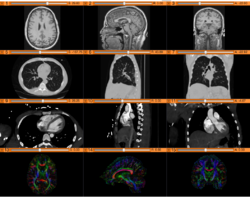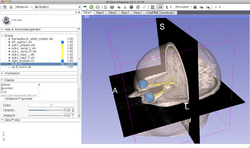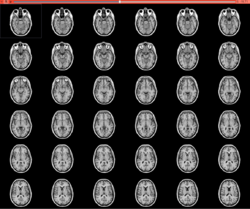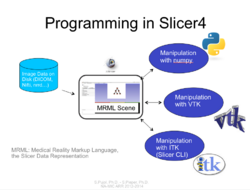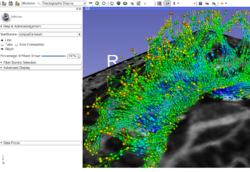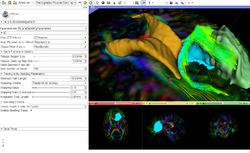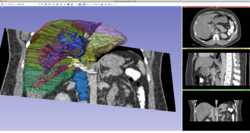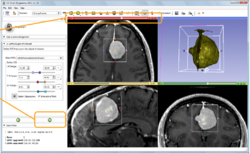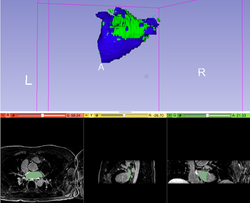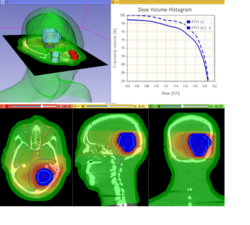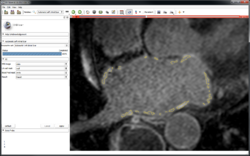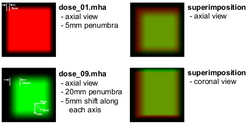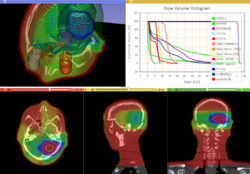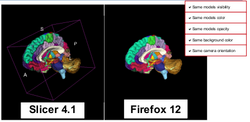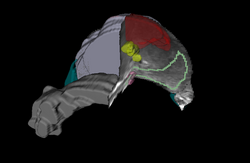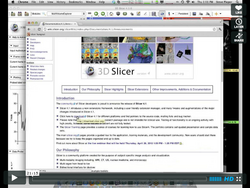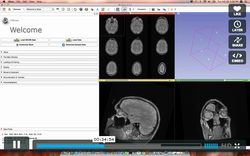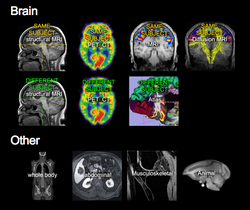Difference between revisions of "Documentation/4.2/Training"
From Slicer Wiki
Tag: 2017 source edit |
|||
| (57 intermediate revisions by 7 users not shown) | |||
| Line 1: | Line 1: | ||
| + | <noinclude>{{documentation/historicaltraining}}</noinclude> | ||
__TOC__ | __TOC__ | ||
=Introduction: Slicer {{documentation/version}} Tutorials= | =Introduction: Slicer {{documentation/version}} Tutorials= | ||
| − | |||
*This page contains "How to" tutorials with matched sample data sets. They demonstrate how to use the 3D Slicer environment (version {{documentation/version}} release) to accomplish certain tasks. | *This page contains "How to" tutorials with matched sample data sets. They demonstrate how to use the 3D Slicer environment (version {{documentation/version}} release) to accomplish certain tasks. | ||
*For tutorials for other versions of Slicer, please visit the [[Training| Slicer training portal]]. | *For tutorials for other versions of Slicer, please visit the [[Training| Slicer training portal]]. | ||
| − | *For "reference manual" style documentation, please visit the [[Documentation/{{documentation/version}}|Slicer {{documentation/version}} documentation page] | + | *For "reference manual" style documentation, please visit the [[Documentation/{{documentation/version}}|Slicer {{documentation/version}} documentation]] page. |
| − | *For questions related to the Slicer4 Compendium, please send an e-mail to '''[http://www.na-mic.org/Wiki/index.php/User:SPujol Sonia Pujol, Ph.D]''' | + | *For an overview of Slicer and its abilities please see [http://www.slicer.org/publications/item/view/2219 3D Slicer as an Image Computing Platform for the Quantitative Imaging Network]. |
| − | + | *For questions related to the Slicer4 Compendium, please send an e-mail to '''[http://www.na-mic.org/Wiki/index.php/User:SPujol Sonia Pujol, Ph.D.]'''. | |
=General Introduction= | =General Introduction= | ||
| Line 76: | Line 76: | ||
*Author: Sonia Pujol, Ph.D., Ron Kikinis, M.D. | *Author: Sonia Pujol, Ph.D., Ron Kikinis, M.D. | ||
*Audience: End-users and developers | *Audience: End-users and developers | ||
| − | + | *Modules presented: Main GUI, add data, interactive editor, tractography interactive seeding, tractography display. | |
*The [[Media:WhiteMatterExplorationData.zip| White Matter Exploration datasets]] contains a single tensor Diffusion Tensor data set of a patient with a brain tumor. | *The [[Media:WhiteMatterExplorationData.zip| White Matter Exploration datasets]] contains a single tensor Diffusion Tensor data set of a patient with a brain tumor. | ||
|align="right"| | |align="right"| | ||
| Line 85: | Line 85: | ||
{|width="100%" | {|width="100%" | ||
| | | | ||
| − | *The [[Media: | + | *The [[Media:3DVisualizationDICOM_RadiologyApplications_SoniaPujol_RSNA2012.pdf | Slicer4RSNA]] course guides through 3D data loading and visualization of DICOM images for Radiology Applications in Slicer4. |
*Author: Sonia Pujol, Ph.D., Kitt Shaffer, M.D., Ph.D. | *Author: Sonia Pujol, Ph.D., Kitt Shaffer, M.D., Ph.D. | ||
*Audience: Radiologists and users of Slicer who need a more comprehensive overview over Slicer4 visualization capabilities. | *Audience: Radiologists and users of Slicer who need a more comprehensive overview over Slicer4 visualization capabilities. | ||
| − | *The [[Media: | + | *The [[Media:3Dvisualization_DICOM_Data-RSNA2012-Part1.zip | Slicer4RSNAdataset1]] and [[Media:3Dvisualization_DICOM_Data-RSNA2012-Part2.zip| Slicer4RSNAdataset2]] contain a series of MR and CT scans, and 3D models of the brain, lung and liver. |
|align="right"| | |align="right"| | ||
[[Image:Slicer4RSNA_2.png|right|250px|]] | [[Image:Slicer4RSNA_2.png|right|250px|]] | ||
|} | |} | ||
| − | |||
==Slicer4 Quantitative Imaging tutorial== | ==Slicer4 Quantitative Imaging tutorial== | ||
| Line 103: | Line 102: | ||
|align="right"| | |align="right"| | ||
[[Image:Slicer4_QuantitativeImaging.png|right|250px|]] | [[Image:Slicer4_QuantitativeImaging.png|right|250px|]] | ||
| + | |} | ||
| + | =Summer 2013 Tutorial contest= | ||
| + | |||
| + | ==Cardiac MRI Toolkit== | ||
| + | {|width="100%" | ||
| + | | | ||
| + | *[[Media:Cardiac MRI Toolkit Tutorial Summer2013.pdf|Cardiac MRI Toolkit]] | ||
| + | *Authors: Salma Bengali, Josh Cates, SCI, Utah | ||
| + | *Dataset: [[Media:Cardiac_MRI_Toolkit_Tutorial_Data.zip|Cardiac MRI Toolkit Tutorial Dataset]] | ||
| + | |align="right"| | ||
| + | [[Image:CMRToolkit_Tutorial_Image.png|250px]] | ||
| + | |} | ||
| + | |||
| + | ==HelloCLI== | ||
| + | {|width="100%" | ||
| + | | | ||
| + | *[[Media:Hello_CLI_TutorialContestSummer2013.pdf|HelloCLI]] | ||
| + | *Authors: Nadya Shusharina, Greg Sharp, MGH, Boston | ||
| + | *Dataset: [[Media:Hello_CLI_TutorialContestSummer2013.zip|HelloCLI Dataset]] | ||
| + | |align="right"| | ||
| + | [[Image:Cli_icon.png|300px]] | ||
| + | |} | ||
| + | |||
| + | ==SlicerRT== | ||
| + | {|width="100%" | ||
| + | | | ||
| + | *[[Media:SlicerRT_TutorialContestSummer2013.pdf|SlicerRT Tutorial]] | ||
| + | *Authors: Csaba Pinter, Andras Lasso (Queen's), Kevin Wang (PMH, Toronto) | ||
| + | *Dataset: [[Media:CsabaPinter-SlicerRtTutorial_Namic2013June.zip|SlicerRT Dataset]] | ||
| + | |align="right"| | ||
| + | [[Image:667px-SlicerRT_0.10_IsocenterShiftingEvaluation.png|250px]] | ||
|} | |} | ||
| + | ==DTIPrep== | ||
| + | {|width="100%" | ||
| + | | | ||
| + | *[[Media:DTIPrep_TutorialContestSummer2013.pdf|DTIPrep]] | ||
| + | *Authors: Dave Welch, SINAPSE, IOWA | ||
| + | *Dataset: [[Media:DTIPrepData_TutorialContestSummer2013.zip|DTIPrep Dataset]] | ||
| − | =Summer 2012 Tutorial contest | + | =Summer 2012 Tutorial contest= |
==Automatic Left Atrial Scar Segmenter == | ==Automatic Left Atrial Scar Segmenter == | ||
| Line 115: | Line 151: | ||
*Dataset: [http://wiki.na-mic.org/Wiki/index.php/File:CARMA-LA-Scar_TutorialContestSummer2012.zip CARMA-LA-Scar data] | *Dataset: [http://wiki.na-mic.org/Wiki/index.php/File:CARMA-LA-Scar_TutorialContestSummer2012.zip CARMA-LA-Scar data] | ||
|align="right"| | |align="right"| | ||
| + | [[Image:carma_afib_auto_scar.png|250px]] | ||
|} | |} | ||
| − | ==Qualitative and quantitative comparison of | + | ==Qualitative and quantitative comparison of two RT dose distributions== |
{|width="100%" | {|width="100%" | ||
| | | | ||
| Line 123: | Line 160: | ||
*Authors: James Shackleford, Nadya Shusharina, Greg Sharp, MGH | *Authors: James Shackleford, Nadya Shusharina, Greg Sharp, MGH | ||
|align="right"| | |align="right"| | ||
| + | [[Image:SynteticDoseDistribution.png|250px]] | ||
|} | |} | ||
| Line 131: | Line 169: | ||
*Authors: Kevin Wang, Csaba Pinter, Andras Lasso, PMH, Queen's | *Authors: Kevin Wang, Csaba Pinter, Andras Lasso, PMH, Queen's | ||
|align="right"| | |align="right"| | ||
| + | [[Image:Wang-DoseAccumulationforAdaptiveRadiationTherapy TutorialContestSummer2012-fig1.png|250px]] | ||
|} | |} | ||
| Line 139: | Line 178: | ||
*Authors: Nicolas Rannou, Daniel Haehn, Children's Hospital | *Authors: Nicolas Rannou, Daniel Haehn, Children's Hospital | ||
|align="right"| | |align="right"| | ||
| + | [[Image:WebdGLExport.png|250px]] | ||
|} | |} | ||
| Line 144: | Line 184: | ||
{|width="100%" | {|width="100%" | ||
| | | | ||
| − | *[http:// | + | *[http://www.slicer.org/w/img_auth.php/f/f1/OpenIGTLinkTutorial_Slicer4.1.0_JunichiTokuda_Apr2012.pdf OpenIGTLink] |
*Authors: Junichi Tokuda, BWH | *Authors: Junichi Tokuda, BWH | ||
|align="right"| | |align="right"| | ||
| + | [[Image:OpenIGTLink-Tracking.png|250px]] | ||
|} | |} | ||
=Additional resources = | =Additional resources = | ||
| + | |||
{|width="100%" | {|width="100%" | ||
| + | | | ||
| + | *Title: [https://wiki.cancerimagingarchive.net/display/Public/Hands-on+Tutorial+-+Using+3D+Slicer+with+the+Prostate-Diagnosis+data Visualizing Prostate-Diagnosis images and segmentations] tutorial from [http://cancerimagingarchive.net/about-archive.html The Cancer Imaging Archive (TCIA)]. | ||
| + | * Author: Justin Kirby | ||
| + | *Audience: Novice 3D Slicer users interested in visualizing prostate segmentations hosted on TCIA. | ||
| + | *Summary: 3D Slicer was used to generate NRRD segmentations of the following prostate components: prostate gland boundary; internal capsule; central gland, peripheral zone; seminal vesicles; urethra; cancer – dominant nodule; neurovascular bundle; penile bulb; ejaculatory duct; veru-montanum; rectum. These segmentations are currently available for [https://wiki.cancerimagingarchive.net/display/Public/Prostate-Diagnosis 5 subjects from TCIA’s Prostate-Diagnosis image collection]. The [http://www.slicer.org/wiki/File:ProstateDx-01-0006-1.zip archive] contains both the DICOM images and the NRRD file for one of the 5 available subjects. | ||
| + | |align="right"|[[Image:NCIA-prostate.png|250px]] | ||
| + | |- | ||
| | | | ||
* This ''Slicer 4.1 [http://vimeo.com/41096643 webinar]'' presents the new features and improvements of the release, and a brief overview of work for the next release. | * This ''Slicer 4.1 [http://vimeo.com/41096643 webinar]'' presents the new features and improvements of the release, and a brief overview of work for the next release. | ||
| Line 171: | Line 220: | ||
|align="right"|[[Image:RegLib Banner.png|250px]] | |align="right"|[[Image:RegLib Banner.png|250px]] | ||
|} | |} | ||
| + | |||
| + | = External Resources = | ||
| + | |||
| + | == Using the Editor == | ||
| + | |||
| + | This set of tutorials about the use of slicer in paleontology is very well written and provides step-by-step instructions. Even though it covers slicer version 3.4, many of the concepts and techniques have applicability to the new version and to any 3D imaging field: | ||
| + | |||
| + | * [http://openpaleo.blogspot.com/2008/12/3d-slicer-tutorial.html Open Source Paleontologist: 3D Slicer: The Tutorial] | ||
| + | * [http://openpaleo.blogspot.com/2008/12/3d-slicer-tutorial-part-ii.html Open Source Paleontologist: 3D Slicer: The Tutorial Part II] | ||
| + | * [http://openpaleo.blogspot.com/2008/12/3d-slicer-tutorial-part-iii.html Open Source Paleontologist: 3D Slicer: The Tutorial Part III] | ||
| + | * [http://openpaleo.blogspot.com/2008/12/3d-slicer-tutorial-part-iv.html Open Source Paleontologist: 3D Slicer: The Tutorial Part IV] | ||
| + | * [http://openpaleo.blogspot.com/2009/03/3d-slicer-tutorial-part-v.html Open Source Paleontologist: 3D Slicer: The Tutorial Part V] | ||
| + | * [http://openpaleo.blogspot.com/2009/03/3d-slicer-tutorial-part-vi.html Open Source Paleontologist: 3D Slicer: The Tutorial Part VI] | ||
| + | |||
| + | == User Contributions == | ||
| + | See the [[Documentation/{{documentation/version}}/Training/UserContributions|User Contributions Page]] for more content. | ||
Latest revision as of 22:13, 22 November 2022
Home < Documentation < 4.2 < Training
 |
This section is currently out-of-date and may contain errors but is retained for historical reference. Up-to-date training materials can be found at Documentation/Nightly/Training |
Contents
Introduction: Slicer 4.2 Tutorials
- This page contains "How to" tutorials with matched sample data sets. They demonstrate how to use the 3D Slicer environment (version 4.2 release) to accomplish certain tasks.
- For tutorials for other versions of Slicer, please visit the Slicer training portal.
- For "reference manual" style documentation, please visit the Slicer 4.2 documentation page.
- For an overview of Slicer and its abilities please see 3D Slicer as an Image Computing Platform for the Quantitative Imaging Network.
- For questions related to the Slicer4 Compendium, please send an e-mail to Sonia Pujol, Ph.D..
General Introduction
Slicer Welcome Tutorial
|
Slicer4Minute Tutorial
|
Slicer4 Data Loading and 3D Visualization
|
Tutorials for software developers
Slicer4 Programming Tutorial
|
Specific functions
Slicer4 Diffusion Tensor Imaging Tutorial
|
Slicer4 Neurosurgical Planning Tutorial
|
Slicer4 3D Visualization of DICOM images for Radiology Applications
|
Slicer4 Quantitative Imaging tutorial
|
Summer 2013 Tutorial contest
Cardiac MRI Toolkit
|
HelloCLI
|
SlicerRT
|
DTIPrep
Summer 2012 Tutorial contestAutomatic Left Atrial Scar Segmenter
Qualitative and quantitative comparison of two RT dose distributions
Dose accumulation for adaptive radiation therapy
WebGL Export
OpenIGTLink
Additional resources
External ResourcesUsing the EditorThis set of tutorials about the use of slicer in paleontology is very well written and provides step-by-step instructions. Even though it covers slicer version 3.4, many of the concepts and techniques have applicability to the new version and to any 3D imaging field:
User ContributionsSee the User Contributions Page for more content. |
